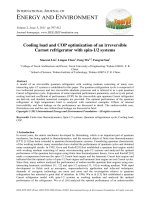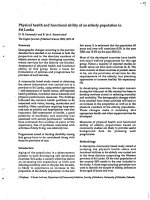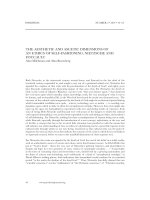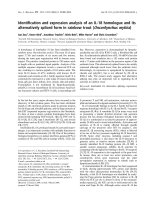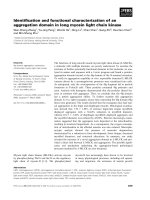Stereochemical assignment and total synthesis of an antimalarial lipopeptide
Bạn đang xem bản rút gọn của tài liệu. Xem và tải ngay bản đầy đủ của tài liệu tại đây (4.78 MB, 268 trang )
STEREOCHEMICAL ASSIGNMENT AND TOTAL SYNTHESIS OF
AN ANTIMALARIAL LIPOPEPTIDE
SHIBAJI KUMAR GHOSH
NATIONAL UNIVERSITY OF SINGAPORE
2011
STEREOCHEMICAL ASSIGNMENT AND TOTAL SYNTHESIS OF
AN ANTIMALARIAL LIPOPEPTIDE
SHIBAJI KUMAR GHOSH
(M.Sc, UNIVERSITY OF CALCUTTA)
A THESIS SUBMITTED FOR THE DEGREE OF
DOCTOR OF PHILOSOPHY
DEPARTMENT OF CHEMISTRY
NATIONAL UNIVERSITY OF SINGAPORE
2011
To my wife
i
ACKNOWLEDGEMENTS
I would like to express my sincere thanks and appreciation to my research advisor,
Assistant Prof. Dr. Martin J. Lear, for his guidance, support, encouragement and patience
throughout the completion of this work.
I would like to thank our collaborators, Dr. Mark Butler and Dr. Brinda for their
suggestions and supply of the natural product. I would also like to thank Dr. Kevin Tan
group for helping me to test the antimalarial activity of the lipopeptide.
I am grateful to all past and present members of Dr. Lear group for their kind help,
useful discussions and friendship. I would especially thank Dr. Patil, Dr. Bastien Reux,
Mun Hong, Santosh, Stanley, Eugene, Sandip, Kunal for their timely help, co-operation
and constant support.
I wish to thank Mdm. Han Yanhui and Mr. Wong Chee Peng for their timely
assistance with NMR measurements and Mdm. Wong Lai Kwai with Mass Spectroscopy
measurements.
I am also grateful to my parents and younger brother for their continuous support
and enthusiasm.
This thesis is dedicated to my beloved wife Tumpa for her incredible support and
sacrifice during my graduate studies.
ii
TABLE OF CONTENTS
Acknowledgments
i
Table of contents
ii
Summary
vi
List of Tables
vii
List of Figures
viii
List of Schemes
x
Abbreviations
and symbols
xiii
Publications
xx
Chapter 1
Introduction 1
1.1
Malaria background
1
1.1.1 Life cycle of the malaria parasite 2
1.1.2 Haemoglobin metabolism 3
1.2
Antimalarial drugs
5
1.2.1 Casual prophylaxis 5
1.2.2 Suppressive prophylaxis 5
1.2.3 Clinical cure 5
1.2.4 Radical cure 5
1.2.5 Controlling transmission 6
1.2.6 Qunoline with secondary alcohols 7
1.2.7 8-aminoquinolines 7
iii
1.2.8 4-aminoquinolines 7
1.2.9 Antifolates 7
1.2.10 Antibiotics 8
1.2.11 Phenanthrenes 8
1.2.12 Artimisinins/Sesquiterpene 9
1.3
Antimalarial drug resistance
9
1.4
Antimalarial drug targets 10
1.4.1 Protein kinases 10
1.4.2 Choline transporter 11
1.4.3 DOXP reductoisomerase 11
1.4.4 Purine salvage enzyme HGXPRT 12
1.4.5 Lactate dehydrogenase 12
1.4.6 Plasmepsins 13
1.4.7 Falcipains 13
1.5
Antimalarial peptides
14
1.6
Aims of this study
15
References 16
Chapter 2
Hydrolysis of the peptide and identification of amino acids 21
2.1
Hydrolysis of peptide N1708
21
2.2
Stereochemical assignment of the aspartic acid residue
23
2.3
Conclusion
25
Chapter 3
Synthesis of 2-Amino-3, 4-Dimethylpent-4-Enoic Acid 26
3.1
Direct methylation of aspartic acid
26
iv
3.2
Synthetic plan via 1, 3-oxazin-6-ones
29
3.3
Synthetic plan with threonine
31
3.4
Proline catalysed Mannich reaction
33
3.5
Conclusion 38
References 39
Chapter 4
Synthesis of 3-Amino-2-Hydroxy-2-Methylsuccinic Acid 41
4.1
1
st
Generation synthesis from L-Tartaric acid 41
4.2
2
nd
Generation synthesis from hydroxyacetone
43
4.3
Sharpless Asymmetric Aminohydroxylation 45
4.4
Sharpless Asymmetric Dihydroxylation 45
4.5
Changing TBS group to benzyl group 46
4.6
Inserting p-Methoxybenzyl (PMB) group 50
4.7
Conclusion 68
References 69
Chapter 5
Synthesis of 5-Methyl-∆
3,4
Decanoic Acid 72
5.1
Asymmetric methylation using Evan’s chiral auxiliary 72
5.2
Model studies of Julia-Kocienski olefination 74
5.3
2
nd
Generation synthetic plan 75
5.4
Synthesis of other enantiomer of the fatty acid 79
5.5
Conclusion 80
References 81
Chapter 6
Coupling of Fragments & Full Structural Assignment 82
6.1
Peptide coupling 82
v
6.2
Conclusion 94
References 95
Experimental Section 96
Appendices 160
vi
SUMMARY
Malaria is one of the three prime causes (together with tuberculosis and AIDS)
responsible for the high mortality in this world. 300-500 Millions people suffer from the
disease every year resulting in about one million deaths. In recent years, malaria is
considered as a complex multisystem disorder. As more than 40% of the world’s
population lives in malaria endemic areas, the challenge is to understand the complexities
of this disease and develop potential tools for improving the present scenario. There is
also the immediate need for the discovery of cost effective drugs or vaccines to fight
mainly chloroquine-resistant strains of P. falciparum.
The lipopeptide (N1708) isolated
from Streptomyces sp. using bioassay-guided
isolation by MerLion Pharmaceuticals exhibits promising activity against Plasmodium
falciparum (IC
50
= 0.8 µM against 3D7 strain). NMR and mass analyses suggest that this
peptide contains two non-proteinogenic amino acids, one aspartic acid and a ten carbon
long chain fatty acid containing a trans-double bond and a chiral centre. As it is a well-
known problem that the half life of peptide drugs is short because of the enzymatic
hydrolysis of the amide bond formed by proteinogenic amino acids, thereby we are
interested to find out the configuration of these six chiral centres (one of them is
quaternary) present in this lipopeptide. Synthesis and stereochemical assignment of the
non-proteinogenic amino acids and rest of the fragments have been performed in this
work. The non-proteinogenic amino acids have been synthesised and their absolute
configuration assigned to the chiral centres with the help of Marfey’s reagent. The full
structure of N1708 has been confirmed by the total synthesis of the targeted lipopeptide.
vii
LIST OF TABLES
Table 3.1: β-Methylation studies of protected aspartic acid. 27
Table 3.2: Further β-methylation studies of protected aspartic acid. 28
Table 3.3: Reaction conditions to manipulate the cyano group. 32
Table 3.4: Wittig reaction for the methenylation. 34
Table 3.5: PMP deprotection. 35
Table 4.1: Oxidation of azido-alcohol. 42
Table 4.2: Oxidation of Boc protected amino-alcohol (4-8). 43
Table 4.3: Benzylation of tri-substituted allylic alcohol. 47
Table 4.4: Debenzylation. 48
Table 4.5: PMB protection of hydroxyacetone. 51
Table 4.6: Oxidation studies of 4-68R. 56
Table 4.7: Oxidation studies of 4-79R. 59
Table 5.1: Methylation using different bases. 73
Table 5.2: Oxidation studies. 79
Table 6.1: Chemical shift values (δ
ppm
). 89
viii
LIST OF FIGURES
Figure 1.1: Global malaria distribution and endemicity. 2
Figure 1.2: Life cycle of Plasmodium falciparum. 3
Figure 1.3: General haemoglobin catabolism pathway. 4
Figure 1.4: Structurally different antimalarial drugs. 6
Figure 1.5: Radical mechanism of artemisinin class of drug. 8
Figure 1.6: Example of antimalarial peptides. 14
Figure 1.7: Linear structure and fragments of the isolated natural lipopeptide. 15
Figure 2.1: Linear structure and fragments of the isolated natural lipopetide N1708. 22
Figure 2.2: Prep HPLC chromatogram of Cbz protected amino acids from peptide N1708.
22
Figure 2.3: Mechanism of lactone formation. 23
Figure 2.4: LCMS chromatogram to determine the absolute stereochemistry. 24
Figure 3.1: X-ray crystal. 30
Figure 3.2: Mechanism of Tebbe olefination. 35
Figure 3.3: Determination of absolute configuration. 36
Figure 3.4: LCMS chromatogram to determine the absolute stereochemistry. 37
Figure 3.5: Mass chromatogram of the derivatised desired amino acid. 37
Figure 4.1: Proposed intermediates for avoiding lactone formation. 49
Figure 4.2: TBS migration due to high functional density in the small molecule. 55
Figure 4.3: Boc migration in strong basic medium. 58
ix
Figure 4.4: LCMS profile of column purified products (4-82 and 4-83) using Schöllkopf
auxiliary. 60
Figure 4.5: LCMS of mixture of two diastereomers. 63
Figure 4.6: LCMS chromatogram for comparison. 65
Figure 5.1: LCMS data for asymmetric methylation. 73
Figure 5.2: Mechanism of Julia-Kocienski olefination. 75
Figure 5.3: GCMS profile of Julia-Kocienski reaction using NaHMDS. 77
Figure 5.4: GCMS profile of Julia-Kocienski reaction using KHMDS. 78
Figure 6.1: Alphabetic representation of the full peptide structure. 88
Figure 6.2: Differences of chemical shift of corresponding carbon between S and R.90
Figure 6.3: Comparison of differences in
13
C NMR (in CDCl
3
)
among N, S and R forms
of lipopeptide N1708. 90
Figure 6.4: LCMS Chromatogram of S. 91
Figure 6.5: LCMS Chromatogram of N. 91
Figure 6.6: LCMS Chromatogram of R. 91
Figure 6.7:
1
H-NMR (500 MHz) comparison in CD
3
OD. 93
Figure 6.8:
13
C-NMR (125 MHz) comparison in CD
3
OD. 93
x
LIST OF SCHEMES
Scheme 3.1: 1
st
Generation synthetic plan of isoleucine derivative (3-7a). 26
Scheme 3.2: Changing the protecting groups. 28
Scheme 3.3: 2
nd
Generation synthetic plan of isoleucine derivative (3-7). 30
Scheme 3.4: 3
rd
Generation synthetic plan of isoleucine derivative (3-7b). 31
Scheme 3.5: Attempts to replace -OMs with different nucleophiles. 33
Scheme 3.6: 4
th
Generation synthesis of the isoleucine derivative (3-36). 34
Scheme 4.1: 1
st
Generation synthesis of β-disubstituted aspartic acid derivative. 42
Scheme 4.2: Staudinger reduction of azide and Boc protection. 42
Scheme 4.3: 2
nd
Generation synthesis of β-disubstituted aspartic acid derivative. 44
Scheme 4.4: Sharpless asymmetric aminohydroxylation strategy. 45
Scheme 4.5: Sharpless asymmetric dihydroxylation strategy. 46
Scheme 4.6: Benzylation of tri-substituted allylic alcohol. 47
Scheme 4.7: Debenzylation and azide reduction. 47
Scheme 4.8: Reduction of azide and protection with FmocCl. 48
Scheme 4.9: Debenzylation in presence of Fmoc group. 48
Scheme 4.10: Lactone formation. 49
Scheme 4.11: Attempt to form cyclic urethane. 49
Scheme 4.12: Reduction of ester and attempt to form ketal. 50
Scheme 4.13: TBDPS protection and debenzylation. 50
Scheme 4.14: PMB protection of hydroxyacetone. 51
Scheme 4.15: Preparation of azido alcohol with PMB group. 52
Scheme 4.16: Synthesis of tetraol for determining the absolute configuration. 52
xi
Scheme 4.17: Plausible mechanism for side product formation. 53
Scheme 4.18: Functional group manipulation. 53
Scheme 4.19: Functional group manipulation. 54
Scheme 4.20: Oxidation of primary alcohol. 55
Scheme 4.21: Functional group manipulation. 55
Scheme 4.22: Functional group manipulation. 56
Scheme 4.23: Protection of acid and alcohol in one step. 57
Scheme 4.24: Converting the ester group to an amide group. 58
Scheme 4.25: Exploring Schöllkopf auxiliary for chirality control. 59
Scheme 4.26: Cleaving of auxiliary. 61
Scheme 4.27: PMB deprotection under buffered pH 7.5. 62
Scheme 4.28: Established protocol to synthesise the desired amino acid 4-99. 64
Scheme 4.29: Still-Gennari HWE modification. 66
Scheme 4.30: Stereoselective synthesis of the Z-isomer. 66
Scheme 4.31: Final complete synthetic plan. 67
Scheme 5.1: 1
st
Generation synthetic plan of fatty acid portion. 73
Scheme 5.2: Model study for sulfone formation and olefination reaction. 74
Scheme 5.3: Kocienski modified Julia olefination reaction with heptanal. 75
Scheme 5.4: 2
nd
Generation synthetic plan. 76
Scheme 5.5: Oxidation studies. 79
Scheme 5.6: Synthesis of (R)-fatty acid. 80
Scheme 6.1: Synthesis of dipeptide 6-4. 82
Scheme 6.2: Synthesis of tripeptide. 84
Scheme 6.3: Boc protection. 84
xii
Scheme 6.4: Functional group manipulation. 85
Scheme 6.5: One step procedure for azide reduction, Boc protection. 85
Scheme 6.6: Oxidative cleavage of PMB. 86
Scheme 6.7: Synthesis of azido tripeptide and Staudinger reaction. 86
Scheme 6.8: Final coupling and synthesis of trimethyl ester of target peptide. 87
Scheme 6.9: Conversion of the natural product N1708 to trimethyl ester derivative. 87
Scheme 6.10: Hydrolysis to get target lipopeptide. 92
xiii
ABBREVIATIONS AND SYMBOLS
δ
Chemical shift (in NMR spectroscopy)
1
3
C NMR carbon nuclear magnetic resonance
1
H NMR proton nuclear magnetic resonance
4Å MS 4Å molecular sieves
Ac acetyl
ACN acetonitrile
AD-mix α (DHQ)
2
PHAL+K
2
OsO
2
(OH)
4
+K
3
Fe(CN)
6
AD-mix β (DHQD)
2
PHAL+K
2
OsO
2
(OH)
4
+K
3
Fe(CN)
6
AIBN 2,2'-azo bisisobutyronitrile
AIDS acquired immunodeficiency syndrome
aq. aqueous
AQN anthraquinone
Atm. atmosphere
BAIB bis(acetoxy)iodobenzene
Bn benzyl
Boc t-butoxycarbonyl
(Boc)
2
O di-tert-butyl dicarbonate
br broad
BuLi butyl lithium
Bz benzoyl
calcd calculated
xiv
CAN cerium(IV) Ammonium Nitrate
Cat D cathepsin D
cat. catalytic
Cbz benzyloxycarbonyl
CM cerebral malaria
COSY correlated spectroscopy
CSA camphorsufonic acid
d doublet
DCC N,N'-dicyclohexylcarbodiimide
DCE dichloroethane
DCM dichloromethane
dd doublet of doublets
DDQ 2,3-dichloro-5,6-dicyano-1,4-benzoquinone
DEPT distortionless enhancement by polarization transfer
DHFR dihydrofolate reductase
DHPS deoxyhypusine synthase
(DHQ)
2
PHAL bis(dihydroquinino)phthalazine
(DHQD)
2
PHAL bis(dihydroquinidino)phthalazine
DIAD diisopropyl azodicarboxylate
DIBALH diisobutylaluminium hydride
DIPEA N,N-diisopropylethylamine (Hünig's base)
DMAP N,N-4-dimethylaminopyridine
DMBA dimethylbenzyl acetal
xv
DME dimethoxyethane
DMF N,N-dimethylformamide
DMP Dess-Martin periodinane
DMSO dimethylsulfoxide
DNA deoxyribonucleic acid
DOXP 1-deoxy-D-xylulose-5-phosphate
DPAP1 dipeptidyl aminopeptidase 1
dr diasteromeric ratio
EA ethyl acetate
ee enantiomeric excess
ESI-MS electrospray ionization mass spectrometry
Et ethyl
FDAA 1-fluoro-2,4-dinitrophenyl-5-L-alanine amide
Fmoc 9-fluorenylmethoxycarbonyl
FP falcipain
FV food vacuole
GCMS gas chromatography–mass spectrometry
h hour
HAP histo-aspartic protease
HATU
O-(7-azabenzotriazol-1-yl)-N,N,N’,N’-
tetramethyluronium hexafluorophosphate
HF hydrofluoric acid
HGXPRT hypoxanthine-guanine-xanthine
xvi
phosphoribosyltranferase
HMBC heteronuclear multiple bond correlation
HMDS 1,1,1,3,3,3-hexamethyldisilazane
HMPA N,N,N',N',N'',N''-hexamethylphosphoric triamide
HMQC heteronuclear multiple quantum coherence
HOAt 1-hydroxy-7-azabenzotriazole
HPLC high-performance liquid chromatography
HRMS high resolution mass spectrum
HWE Horner-Wadsworth-Emmons
Hz hertz
IBX 2-iodoxybenzoic acid
IC
50
half maximal inhibitory concentration
Im imidazole
IR infrared
J coupling constant
KHMDS potassium bis(trimethylsilyl)amide
LAH lithium aluminum hydride
LCMS liquid chromatography-mass spectrometry
LDA lithium diisopropylamide
LDH lactate dehydrogenase
LiHMDS lithium bis(trimethylsilyl)amide
M Molar
m meta
xvii
m multiplet
m/z mass to charge ratio
mCPBA m-chloroperbenzoic acid
Me methyl
mg milligram
mL milliliter
mmol millimol
Ms methanesulfonyl
n normal (e.g., unbranched alkyl chain)
NAD
+
nicotinamide adenine dinucleotide
NaHMDS sodium bis(trimethylsilyl)amide
NMO N-methylmorpholine oxide
NMR nuclear magnetic resonance
nOe nuclear Overhauser enhancement
NPP new permeation pathway
o ortho
O/N overnight
p para
PCC pyridinium chlorochromate
Pd/C palladium on charcoal
PDC pyridinium dichromate
PG protecting group
Ph phenyl
xviii
Piv pivaloyl
PK protein kinase
PM plasmepsin
PMB p-methoxybenzyl
PMP p-methoxyphenyl
ppm parts per million
PPM parasite plasma membrane
PPTS pyridinium p-toluenesulfonate
psi pound per square inch
PTSA p-toluenesulfonic acid
Py pyridine
q quartet
RBC red blood cell
R
f
retention factor
RNA ribonucleic acid
rt room temperature
s singlet
S.M starting material
SAD Sharpless asymmetric dihydroxylation
t triplet
t (or) tert tertiary
TBAF tetra-n-butylammonium fluoride
TBAI tetra-n-butylammonium iodide
xix
TBDPS t-butyldiphenylsilyl
TBS t-butyldimethylsilyl
TCA tricarboxylic acid cycle
TCA trichloroacetimidate
TEA Triethylamine
TEMPO (2,2,6,6-tetramethylpiperidin-1-yl)oxidanyl
TES triethyl silyl
TESOTf triethylsilyl trifluoromethanesulfonate
Tf triflate (trifluoromethanesulfonate)
TFA trifluoroacetic acid
THF tetrahydrofuran
TLC thin layer chromatography
TMS trimethylsilyl
TMSOTf trimethylsilyl trifluoromethanesulfonate
TPAP tetrapropylammonium perruthenate
Ts p-toluenesulfonyl
UV ultraviolet
µM micromolar
xx
PUBLICATIONS
1. Absolute Configuration and Total Synthesis of a Novel Antimalarial Lipopeptide by
the de Novo Preparation of Chiral Nonproteinogenic Amino Acids, Shibaji K. Ghosh,
Brinda Somanadhan, Kevin S W. Tan, Mark S. Butler, and
Martin J. Lear Org. Lett.
2012, 14, 1560-1563.
2. Synthesis of 2-C-Methylerythritols and 2-C-Methylthreitols via Enantiodivergent
Sharpless Dihydroxylation of Trisubstituted Olefin, Shibaji K. Ghosh, Mark S. Butler,
and Martin J. Lear Tetrahedron Lett. (in press).
Conference Publications:
1. Shibaji K. Ghosh, Martin J. Lear; “Stereochemical Assignment and Total Synthesis of
an Anti-malarial Lipopeptide”, The 6
th
Mathematics and Physical Science
Graduate Congress, University of Malaya, Malaysia , 13
th
- 15
th
Dec, 2010. (Oral
Presentation)
2. Shibaji K. Ghosh, Brinda Somanadhan, Mark S. Butler,
Martin J. Lear; “Amino Acid
Stereochemical Assignment and Total Synthesis of A Natural Anti-malarial Peptide”,
239
th
ACS National Meeting, San Francisco, CA, United States, 21
st
- 25
th
Mar,
2010.(Poster)
3. Shibaji K. Ghosh, Brinda Somanadhan, Mark S. Butler,
Martin J. Lear; “Synthetic
Determination of the Absolute Configuration of A Natural Anti-malarial Peptide”, 6
th
Singapore International Chemical Conference, Singapore, 15
th
– 18
th
Dec, 2009.
(Poster)
4. Shibaji Kumar Ghosh, Martin J. Lear; “Asymmetric Synthesis of 2-C-methylerythritol
and 2-C-methylthreitol in High Enantiomeric Purity”, Tenth Tetrahedron
Symposium, Paris, France, 23
rd
– 26
th
Jun, 2009. (Poster)
1
CHAPTER 1
Introduction
1.1 Malaria background
Malaria is one of the three prime causes (together with tuberculosis and AIDS)
responsible for high mortality in this world. 300-500 Millions people suffer from the
disease every year resulting in about one million deaths.
1
It is a very old parasitic
disease caused by different types of Plasmodium species namely P. falciparum, P.
vivax, P. malariae and P. ovale. P. falciparum is the most deadly one for the majority
of humans. High fever, chills, headache and vomiting are the signs of malaria. Severe
malaria is traditionally viewed in two pathogenic processes; destruction of red blood
cells (anaemia) and cerebral malaria (CM) due to small vessels blockage in the brain
by sequestered parasites. In recent years, malaria is considered as a complex
multisystem disorder.
2
As more than 40% of the world’s population lives in malaria
endemic areas (Figure 1.1), the challenge is to understand the complexities of this
disease and to produce some potential tools for improving the present scenario. There
is also the immediate need for the discovery of cost effective drugs or vaccines to
fight mainly chloroquine-resistant strains of P. falciparum.
Chapter 1
2
Figure 1.1: Global malaria distribution and endemicity, 2003.*
1.1.1 Life cycle of the malaria parasite
The life cycle of malarial parasites (Figure 1.2) is distinctly divided into two
hosts. The female anopheles mosquito, where the sexual cycle of the parasites takes
place, is the primary host. The secondary host is the human body, which is needed for
completing their asexual cycle. Sporozoites are released into the human blood stream
when an infected female anopheles mosquito bites. Sporozoites first hit the human
liver and begin their asexual cycle resulting in the formation of merozoites which
enter the erythrocytes and grow as trophozoites in the ring stage by feeding on the
host cell haemoglobin. Lysis of the erythrocyte releases merozoites that attack new
erythrocytes thus completing the cycle. This whole process occurs in 48 hours and the
release of merozoits from red blood cells (RBC) causes the sporadic symptoms of
fever, shivering and anaemia, i.e., the characteristics of malaria. During this process,
some immature trophozoites produce gametocytes. The male and female gametocytes
enter into the mosquito when it bites the person carrying the parasite. After reaching
the mid-gut of the mosquito, female gametocytes transform into macro-gametes
whereas the male gametocytes divide into micro-gametes. Next, the male and female
gametes combine to form a zygote. The zygote transforms into sporozoites through

